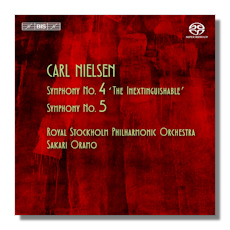
The Internet's Premier Classical Music Source
Related Links
- Nielsen Reviews
- Latest Reviews
- More Reviews
-
By Composer
-
Collections
DVD & Blu-ray
Books
Concert Reviews
Articles/Interviews
Software
Audio
Search Amazon
Recommended Links
Site News
 SACD Review
SACD Review
Carl Nielsen

Symphonies, Volume I
- Symphony #4 "The Inextinguishable", Op. 29
- Symphony #5, Op. 50
Royal Stockholm Philharmonic Orchestra/Sakari Oramo
BIS SACD BIS-2028 69:46 Hybrid Multichannel
Back in 2012 I reviewed Oramo's CD of the Prokofiev 5th and 6th Symphonies (Ondine ODE1181-2) and found the performances convincing in their way but somewhat understated. Well, at times Oramo can be a bit understated in his approach here too, but he mostly offers vital, incisive, highly detailed and well played renditions of these two great Nielsen symphonies.
I don't think I've ever heard the Fourth's first movement played and interpreted any better. It begins appropriately with a rush of energy but then settles down with a somewhat restrained statement of the main theme by the clarinets. Thereafter, the music crackles with vitality and urgency, the movement closing in both triumph and defiance. The pastoral second movement, scored for woodwinds, is suitably subdued, offering that curious mixture of the somber and playful. In the ensuing Poco Adagio Oramo infuses the playing with tension and yearning: the strings are powerfully convincing throughout this movement, at times seeming to scream out for dear life. In the finale Oramo manages to capture the sense of continuing conflict – the battle of the drums comes across with particularly crushing power. Once again, Oramo coaxes fine playing from the strings, especially in the mysterious and atmospheric middle section, and the symphony ends in sheer jubilant triumph. A superb performance from both conductor and orchestra.
The performance of the Fifth is just as convincing. The doubt and wariness of the opening rarely have come across with this kind of foreboding and the sense that Damocles' sword is hovering ever so closely above. The militarism of the ensuing episode is powerfully threatening and dark, the music seeming to convey nightmarish images of death and atrocity. The beautiful theme in the second half is nicely phrased and the final struggle between percussion and that theme brims with a tension that seems to portend cataclysmic events: here the snare drummer plays with power and bluntness, but doesn't add inappropriate jazz-like strokes heard in so many other recordings and performances. The brighter and somewhat philosophical second movement has its high-wire moments of tension, and Oramo captures them and all the shifting moods with a deft hand. One must admire the excellent tuba player whose role in the first fugal section is crucial to any good performance.
Though the competition in these symphonies is strong, from Bernstein, Schønwandt, Berglund, Blomstedt, and many others, this pair of performances must be counted among the finest of both works. The BIS sound reproduction is clear and powerful. The album notes are enlightening. Highest recommendations!
Copyright © 2014, Robert Cummings





















